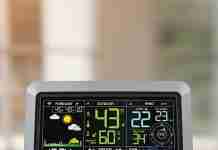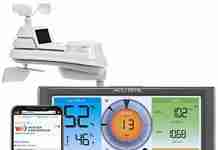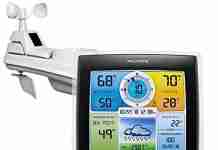Ever wondered what weather variables your basic home weather station might be missing out on? As weather enthusiasts, we all love to keep track of the temperature, humidity, and precipitation levels, but there are other important variables that might not be included in the basic setup. In this article, we will explore some of these lesser-known weather variables that are worth tracking to get a comprehensive understanding of your local climate. From wind speed and direction to UV index and air quality, join us on this journey as we uncover the hidden gems of weather tracking that can greatly enhance your forecasting abilities.
Review contents
Temperature
Wind Chill
When it comes to monitoring temperature, a basic home weather station can provide us with accurate readings. However, there is one important aspect that it might not capture – the wind chill factor. Wind chill is a measure of how cold it feels when wind is factored into the temperature. It takes into account the rate of heat loss from the body due to the combination of wind and cold air. By considering the wind chill factor, we can gain a better understanding of the perceived temperature and how it may impact our comfort and safety outdoors.
Heat Index
On the other end of the temperature spectrum, a basic home weather station may not provide us with the heat index. The heat index takes into account both temperature and humidity levels to determine how hot it feels to the human body. Factors such as high humidity can make it feel much hotter than the actual temperature, which can lead to discomfort, heat exhaustion, or even heatstroke. By tracking the heat index, we can take appropriate measures to protect ourselves from extreme heat and stay safe during hot weather conditions.
Precipitation
Rainfall Intensity
While a basic home weather station can measure rainfall, it may not be able to provide us with information about rainfall intensity. Rainfall intensity refers to the rate at which rain is falling over a given area. It can vary from a gentle drizzle to a heavy downpour. Being aware of rainfall intensity can be particularly helpful in areas prone to flash floods or in situations where heavy rainfall can impact outdoor activities or infrastructure. By tracking rainfall intensity, we can be better prepared and make informed decisions based on the current or expected precipitation rates.
Hail Size
Another important precipitation variable that a basic home weather station may not measure is hail size. Hail is formed when strong updrafts in thunderstorms lift raindrops higher into the cold upper regions of the storm, causing them to freeze into ice pellets. The size of hailstones can vary greatly, from small pea-sized hail to large grapefruit-sized hail. Large hailstones can cause significant damage to property, vehicles, and crops. By tracking hail size, we can assess the potential impact of hailstorms and take appropriate precautions to protect ourselves and our belongings.
Snowfall Accretion
In colder regions, tracking snowfall accretion is crucial for understanding the amount of snow that has accumulated on the ground. While a basic home weather station can measure snowfall, it may not be able to provide us with detailed information on the snowfall’s accretion or buildup. Knowing how much snow has accumulated is essential for various reasons, such as assessing travel conditions, evaluating the risk of avalanches, and planning outdoor activities like skiing or snowboarding. By staying informed about snowfall accretion, we can adjust our plans accordingly and ensure our safety in snowy conditions.
Wind
Wind Gusts
A basic home weather station can provide us with the average wind speed, but it may not have the capability to measure wind gusts. Wind gusts are brief increases in wind speed that occur within a short period. These gusts can be significantly stronger than the average wind speed and can have a substantial impact on our daily activities. From affecting aviation operations to the stability of outdoor structures, wind gusts can be influential factors to consider. By monitoring wind gusts, we can gain a better understanding of the true strength of the wind and its potential effects.
Wind Direction Variability
In addition to wind speed and gusts, a basic home weather station may not be able to provide us with information about wind direction variability. Wind direction variability refers to the changes in wind direction over time. Knowledge of wind direction variability can be beneficial for numerous activities, including aviation, sailing, and even predicting the movement of air pollutants. By tracking wind direction variability, we can make informed decisions and adapt our plans based on the ever-changing direction of the wind.
Humidity
Dew Point
While a basic home weather station can measure relative humidity, it may not provide us with information about the dew point. The dew point is the temperature at which air becomes saturated, leading to the formation of dew or fog. It is a critical factor in determining the potential for condensation, which can impact various aspects of our daily lives. Monitoring the dew point can help us anticipate the formation of fog, assess the risk of frost or ice formation, and make decisions regarding ventilation and energy use in our homes.
Relative Humidity
Although a basic home weather station can measure relative humidity, understanding its significance is vital. Relative humidity refers to the amount of moisture present in the air compared to the maximum amount it can hold at a given temperature. High relative humidity can make us feel uncomfortable and can impact the effectiveness of cooling systems. Low relative humidity, on the other hand, can cause dry skin, respiratory discomfort, and affect indoor plants and wooden furniture. By keeping track of relative humidity, we can take appropriate actions to maintain a comfortable and healthy environment.
Air Pressure
Barometric Pressure Tendency
Monitoring air pressure is one of the essential functions of a basic home weather station. However, it may not give us information about barometric pressure tendency. Barometric pressure tendency refers to the change in atmospheric pressure over time. By observing the barometric pressure tendency, we can gain insights into the weather patterns and predict shifts in weather conditions. Understanding barometric pressure tendency can be particularly valuable for outdoor enthusiasts, farmers, and those who rely on weather forecasts for planning their activities.
Solar Radiation
UV Index
A basic home weather station may not measure the UV index, which is a crucial factor in assessing the potential risk of UV radiation from the sun. The UV index provides an indication of the strength of the sun’s ultraviolet rays, which can cause sunburn, skin damage, and increase the risk of skin cancer. By monitoring the UV index, we can take appropriate measures to protect ourselves from excessive sun exposure, such as wearing sunscreen, sunglasses, and protective clothing, and planning outdoor activities during times of lower UV intensity.
Solar Irradiance
Solar irradiance refers to the amount of solar energy reaching a given area per unit of time. Although a basic home weather station may not measure solar irradiance, understanding this variable can be helpful for those interested in solar power generation, agriculture, or studying the impact of solar radiation on various ecosystems. Solar irradiance data can provide valuable insights into energy production potential, plant growth, and the overall energy balance of a particular region.
Cloud Cover
Cloud Type
While a basic home weather station can provide general information about cloud cover, it may not identify specific cloud types. Cloud type classification includes categories such as cumulus, stratus, cirrus, and nimbus, among others. Recognizing different cloud types can help us make predictions about the weather and understand atmospheric conditions better. For example, certain cloud types may indicate approaching storms, while others may suggest fair weather. By learning about cloud types, we can become more adept at interpreting the sky and making informed judgments about the weather.
Cloud Ceiling Height
The height at which the base of the clouds is located is called the cloud ceiling height. A basic home weather station may not provide this specific information. Cloud ceiling height is crucial for aviation operations, as it determines the minimum altitude at which aircraft can safely fly. It also helps us understand the vertical distribution of clouds and their impact on visibility. By tracking cloud ceiling height, pilots, air traffic controllers, and meteorologists can ensure safe flights and make accurate weather assessments.
Air Quality
Pollutant Levels
A basic home weather station may not have the capability to measure pollutant levels in the air. Pollutant levels include variables such as carbon monoxide, ozone, sulfur dioxide, and particulate matter. Understanding the concentration of pollutants in the air is vital for assessing air quality, especially in urban areas or regions with industrial activity. High levels of pollutants can have detrimental effects on human health, ecosystems, and outdoor air quality. By monitoring pollutant levels, we can take necessary precautions to minimize exposure and advocate for cleaner environments.
Particle Concentration
Particle concentration refers to the number of small particles suspended in the air, often originating from sources such as dust, smoke, or pollen. While a basic home weather station may not provide specific data on particle concentration, it plays a crucial role in assessing air quality and potential health risks. High levels of particle concentration can exacerbate respiratory conditions, cause allergies, or contribute to poor visibility. By monitoring particle concentration, we can make informed decisions about outdoor activities, air filtration, and protecting our respiratory health.
Visibility
Fog Density
While a basic home weather station can measure visibility, it may not give us information about fog density. Fog density refers to the thickness or concentration of fog in a specific area. Fog can greatly reduce visibility, leading to hazardous driving conditions, delays in transportation, and increased chances of accidents. By tracking fog density, we can understand the severity of foggy conditions and take appropriate measures to ensure our safety and well-being.
Haze Levels
Haze refers to the presence of fine particulate matter or pollutants in the air, reducing visibility and often giving the atmosphere a hazy appearance. A basic home weather station may not provide information on haze levels specifically. Monitoring haze levels is critical, especially in areas with high pollution levels or regions affected by wildfires or industrial emissions. High levels of haze can impact air quality, visibility, and potentially pose health risks. By staying informed about haze levels, we can make informed decisions about outdoor activities and protect our respiratory health.
Electrical Conditions
Thunderstorm Activity
While a basic home weather station can detect thunderstorms through changes in air pressure and rainfall, it may not provide specific information about thunderstorm activity. Thunderstorm activity encompasses variables such as the frequency of thunderstorms, the number of lightning strikes, and the severity of the storms. Being aware of thunderstorm activity is crucial for personal safety, as lightning strikes can pose a significant risk outdoors. By monitoring thunderstorm activity, we can take appropriate precautions and ensure our safety during severe weather conditions.
Lightning Detection
Lightning detection refers to the ability to track the occurrence and location of lightning strikes. A basic home weather station may not have the capability to measure or detect lightning. Lightning is not only a spectacular natural phenomenon but also a potentially dangerous one. Being able to detect lightning strikes can provide valuable information for predicting severe weather, issuing warnings, and assessing the overall atmospheric conditions in a given area. By monitoring lightning detection, we can stay informed about the presence and intensity of thunderstorms and take necessary precautions to protect ourselves and our property.
In conclusion, while a basic home weather station provides us with valuable information about temperature, precipitation, wind, humidity, air pressure, cloud cover, visibility, air quality, and electrical conditions, there are several variables it may not measure. These include wind chill, heat index, rainfall intensity, hail size, snowfall accretion, wind gusts, wind direction variability, dew point, barometric pressure tendency, UV index, solar irradiance, cloud type, cloud ceiling height, pollutant levels, particle concentration, fog density, haze levels, thunderstorm activity, and lightning detection. By considering these additional variables and tracking them using specialized equipment or relying on reliable sources, we can gain a more comprehensive understanding of the weather and make informed decisions to ensure our comfort, safety, and well-being in various weather conditions.



































